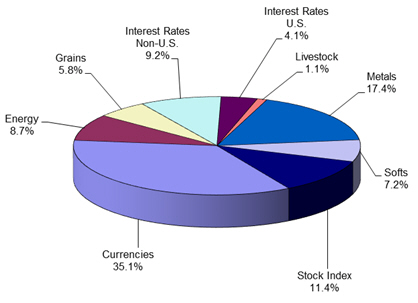Credit risk is the possibility that a loss may occur due to the failure of a counterparty to perform according to the terms of a contract. The Partnership’s/Master’s risk of loss in the event of a counterparty default is typically limited to the amounts recognized in the Statements of Financial Condition and is not represented by the contract or notional amounts of the instruments. The Partnership’s/Master’s risk of loss is reduced through the use of legally enforceable master netting agreements with counterparties that permit the Partnership/Master to offset unrealized gains and losses and other assets and liabilities with such counterparties upon the occurrence of certain events. The Partnership/Master had credit risk and concentration risk, as MS&Co. and/or JPMorgan or their affiliates are or were counterparties or brokers with respect to the Partnership’s/Master’s assets. Credit risk with respect to exchange-traded instruments was reduced to the extent that, through MS&Co. or an MS&Co. affiliate, the Partnership’s/Master’s counterparty was an exchange or clearing organization. The Partnership/Master continue to be subject to such risks with respect to MS&Co. and JPMorgan.
The General Partner monitors and attempts to mitigate the Partnership’s/Master’s risk exposure on a daily basis through financial, credit and risk management monitoring systems, and accordingly, believes that it has effective procedures for evaluating and limiting the credit and market risks to which the Partnership/Master may be subject. These monitoring systems generally allow the General Partner to statistically analyze actual trading results with risk-adjusted performance indicators and correlation statistics. In addition, online monitoring systems provide account analysis of futures, forward and option contracts by sector, margin requirements, gain and loss transactions and collateral positions. (See also “Item 8.Financial Statements and Supplementary Data.” for further information on financial instrument risk included in the notes to financial statements.)
The majority of these financial instruments mature within one year of the inception date. However, due to the nature of the Partnership’s/Master’s business, these instruments may not be held to maturity.
Other than the risks inherent in U.S. Treasury bills, money market mutual fund securities, commodity futures, forwards, options and swaps trading, the Partnership knows of no trends, demands, commitments, events or uncertainties which will result in or which are reasonably likely to result in the Partnership’s liquidity increasing or decreasing in any material way. The Limited Partnership Agreement provides that the General Partner may cause the Partnership to cease trading operations under certain circumstances, including a decrease in net asset value per Redeemable Unit of any Class to less than $400 as of the close of business on any business day. In addition, the General Partner may, in its sole discretion, cause the Partnership to dissolve if the aggregate net assets of the Partnership decline to less than $1,000,000.
(b)Capital Resources.
(i) The Partnership has made no material commitments for capital expenditures.
(ii) The Partnership’s capital consists of the capital contributions of the partners as increased or decreased by gains or losses on trading and by expenses, interest income allocated from the Master, subscriptions, redemptions of Redeemable Units and distributions of profits, if any. Gains or losses on trading cannot be predicted. Market movements in commodities are dependent upon fundamental and technical factors which the Advisor may or may not be able to identify, such as changing supply and demand relationships, weather, government, agricultural, commercial and trade programs and policies, national and international political and economic events and changes in interest rates. Partnership expenses consist of, among other things, clearing fees, ongoing selling agent fees, management fees and General Partner fees. The level of these expenses is dependent upon trading performance and the level of net assets maintained. In addition, the amount of interest income earned by the Partnership is dependent upon (1) the average daily equity maintained in cash in the Partnership’s and/or Master’s accounts, (2) the amount of U.S. Treasury bills and/or money market mutual fund securities held by the Partnership and/or the Master and (3) interest rates over which none of the Partnership, the Master, MS&Co. or JPMorgan has control.
No forecast can be made as to the level of redemptions in any given period. A limited partner may require the Partnership to redeem its Redeemable Units at their net asset value as of the last day of any month on three business days’ notice to the General Partner. There is no fee charged to limited partners in connection with redemptions. Redemptions are generally funded out of the Partnership’s cash holdings and/or redemptions from the Master. For the year ended December 31, 2019, 27,255.8790 Redeemable Units of Class A were redeemed totaling $36,437,556, 13,380.4180 Redeemable Units of Class D were redeemed totaling $18,556,248, 977.2700 Redeemable Units of Class Z were redeemed totaling $1,341,295 and 434.8940 General Partner Redeemable Units of Class Z were redeemed totaling $635,014. For the year ended December 31, 2018, 14,650.7860 Redeemable Units of Class A were redeemed totaling $19,998,537, 9.0000 Redeemable Units of Class Z were redeemed totaling $12,179 and 325.6540 General Partner Redeemable Units of Class Z were redeemed totaling $475,000. For the year ended December 31, 2017, 42,412.1360 Redeemable Units of Class A were redeemed totaling $55,269,803, 60.0000 Redeemable Units of Class D were redeemed totaling $76,657, 879.5740 Redeemable Units of Class Z were redeemed totaling $1,084,192 and 292.1440 General Partner Redeemable Units of Class Z were redeemed totaling $360,000.
For the year ended December 31, 2019, there were subscriptions of 256.3490 Redeemable Units of Class A totaling $338,425. For the year ended December 31, 2018, there were subscriptions of 5,218.4370 Redeemable Units of Class A totaling $7,296,049. For the year ended December 31, 2017, there were subscriptions of 20,613.6240 Redeemable Units of Class A totaling $26,970,421, 4,033.0710 Redeemable Units of Class D totaling $5,000,000, 1,581.6670 Redeemable Units of Class Z totaling $2,060,000 and 215.8170 General Partner Redeemable Units of Class Z totaling $275,265.
19



